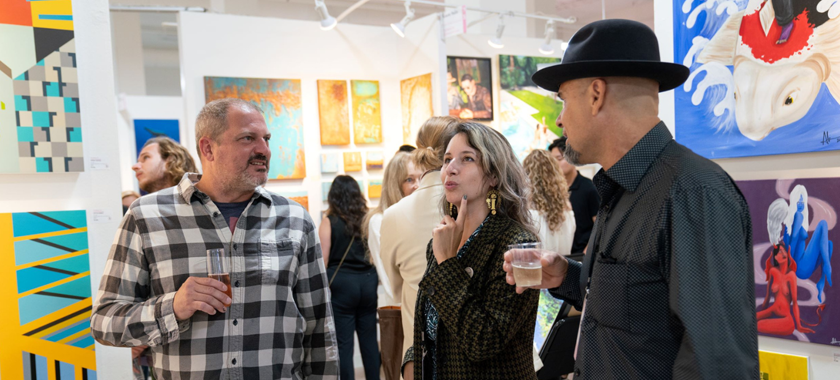
7 Things to Consider When Deciding to Participate in an Art Fair
Thinking about participating in an art fair? We spoke with Alex Mitow, CEO and Co-Founder of Superfine Art Fair, about what to consider before, during, and after the fair and how to set yourself up for success.
Art fairs can be a great way to get your name and work out there. But what factors should you consider before investing your time and resources in participating? How can you maximize opportunities and cultivate sales to get the most out of the experience? We asked Alex Mitow, CEO and Co-Founder of Superfine Art Fair, these questions and more to help you determine if art fairs are the right next step for your arts career. Here are 7 things you need to know from our conversation:
1. Evaluate Your Goals, Then Be Realistic About How You Can Achieve Them.
Mitow suggests first asking yourself “What do I want?” Close your eyes, visualize, and then write it down. If you’re considering one art fair, or several, Mitow says to look at the fair, see what the results of that fair are from other exhibitors who have done it, and what the organizers are putting out in their materials. If it aligns with your goals, consider moving forward.
Then ask yourself “How practical is this art fair for me?” There are art fairs across the country and globe, but how realistic is it for you and your work to travel and stay at that destination? If you haven’t done an art fair before, consider testing out the waters in a city near you to make the logistics of participating less intimidating.
“Stay close to home, that’s what I would suggest,” says Mitow. “Stay close to home unless traveling is just part of your life, you thrive on it, you’ve got the place to stay, and you’ve got the money to do it. But otherwise, if you’re a little hesitant, stay close to home. You’re going to really get your bearings better,” he added.
Superfine has fairs in cities including Miami; San Francisco; Savannah; Washington, DC; Seattle; New York City; and Los Angeles. For your first fair, find whichever city is the closest to you. Rest assured that Superfine (and other major fairs) have done the market research to determine that there are enough people at the income and interest level to support their fairs.
Lastly, for those who may be hesitating if they haven’t yet sold work: “If your work is good and you feel ready, if you feel excited, and you’re hearing from friends and family ‘Oh, my God! You should sell!’ then you’re probably in a good spot to do it,” says Mitow. “It’s not in our best interest to sell you a booth if we don’t think you’re going to succeed. I just had to talk someone out of participating the other day. But if your work is there, and your attitude is there, you can really start to grow by exhibiting at our fair.”
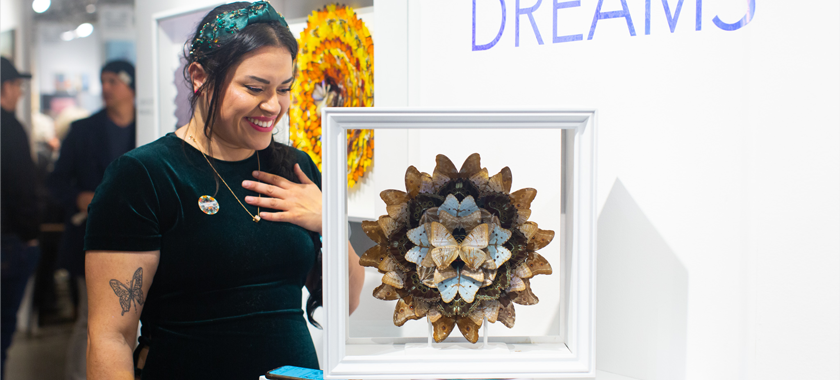
2. Plan Accordingly, and Give Yourself at Least 6 Weeks to Prepare.
Before you fully commit to a fair, first make sure that you have enough work to show! If you’re staying local, within 200 to 300 miles of home, and have been actively creating work, Mitow says at least 6 weeks should be enough time to prepare.
Once you’ve decided you’re going to participate, consider what booth size is manageable. “If you’ve got 6 months to plan, maybe take a larger booth and strategize how you’re going to make the most of it,” says Mitow. If a smaller booth is more realistic and achievable, then go that route.
For an 8 foot booth, which is the smallest that Superfine offers, Mitow suggests not hanging more than 7 to 9 pieces, depending on size. For their most popular size booth, 12 linear feet, he says you could go up to about 15 pieces. “Hang enough so that there’s some drama and excitement, and a little bit of something for everyone,” advises Mitow.
Superfine is a “grab and go” model, meaning that once someone buys a work they can take it. Therefore, Mitow suggests having about 20 works in backup.
Superfine gives its artists a gridded layout of their wall space with designated “do not hang” areas; they also provide the lighting and guidelines for how many works you should hang depending on the size of your booth. Artists are responsible for hanging their art and attending their booth.
Mitow says Superfine provides a list for every city with art handlers, if you’re not comfortable hanging your art and want professional help. “You’ve got four days to make an impression. You don’t want to throw it up on a wall and see what happens. You’ve got to make it look good,” says Mitow. He anticipates hanging an average 8 foot booth is $150, and that hanging a 12 foot booth is around $250.
If you’re doing an out of town fair, you’ll also likely need to anticipate budget for travel, lodgings, and shipping your work to the venue. Mitow acknowledges that shipping can be a huge cost for artists, particularly if you’re using a white glove service. One potential cost-saver, says Mitow, is to find creative ways to consolidate your work and ship it to the venue or a holding facility. For example, if you roll up a canvas and ship it, you can restretch and frame it once there. You could also consider packing artwork in your checked baggage to ensure that it is with you at the fair.
“This goes back to pricing,” says Mitow. “Nobody is paying your costs, they’re paying for an item. It’s in your best interest to do the fair as economically as possible, so that you can offer your artwork at the fairest price possible, and where you can start finding the equilibrium where people buy it,” he added.
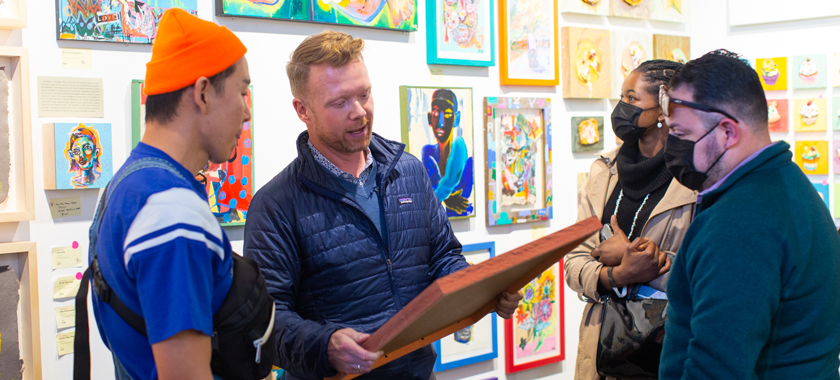
3. Try Not to Spend Too Much Time Obsessing Over Pricing.
Many artists get stuck on this topic, unsure of how to price their work. Mitow says to not overthink it: “The market will dictate what buyers will pay for your work. The people who like your work and want to acquire it will dictate your pricing.”
If you are at a loss about where to start, Mitow says to make educated guesses by talking to friends, looking at comparable works that have sold or are selling by artists at similar career points in your geographic area, and being honest with yourself about what level you’re at.
“Most of the action in the art market is in the $500-$2,500 range per work. That is just a general statistic, and then upwards from $2,500 to $15,000 is active as well, and then smaller works at lower prices,” says Mitow.
Based on this, Mitow advises having works of varying price points and sizes in your booth. For example, your smallest, less complex original works at $500; more complex, larger original works for $2,500 or above; limited prints at $200; an open print (maybe one per year) at $75; stickers, enamel pins, hats, or tee-shirts for anywhere from $10 to $100. This strategy also helps to give context for your pricing; a visitor may think “I understand why this artist is pricing this 36” x 40” work at $8,000 because their smaller works which are equally intricate and equally well-produced are $1,000.”
“It is so smart for artists to have items at all of those levels, because every time someone pays you for something and gives you their email address they become a collector of yours whether they’re a 25 year-old buying something for $25, or whether they’re someone well established who has three homes and is buying a $5,000 canvas,” says Mitow.
4. Be Present at the Fair: You are the Best Person to Represent Your Work.
You’ve decided to participate in an art fair. The best case scenario is for you to be at your booth the whole time, says Mitow.
“The reason our attendees are there is to meet the artists. That is heavy in Superfine marketing, and that’s not something we just came up with. We surveyed attendees, and they want to talk to the artists. They want to know why you created this work and what it is about. They want to know anything interesting and unique about it.”
Mitow underscores that most people do not buy art for the investment. “It is very hard to resell at any level. It’s very, very hard to resell art. People buy art that makes them feel good when it’s in their homes. They also buy it because when someone walks into their home and says ‘Oh, what is that?’ you can tell them a story.”
Contrary to what you might think, you do not have to be what Mitow calls a “super extrovert” to talk to people. “You know what your work is about and why you made it. Just gain comfort by doing it, by talking to people,” he says.
The second best type of representation to have at the fair is a partner, spouse, or close friend. “And preferably, you’re still there,” emphasizes Mitow.
Having someone to “spot” you will help you take breaks and make connections with the other artists around you. Mitow encourages artists to introduce themselves to other exhibiting artists. If it is your first time, say so and ask for advice. If you’re there solo, a fellow artist could also potentially watch your booth if you need to briefly step away.
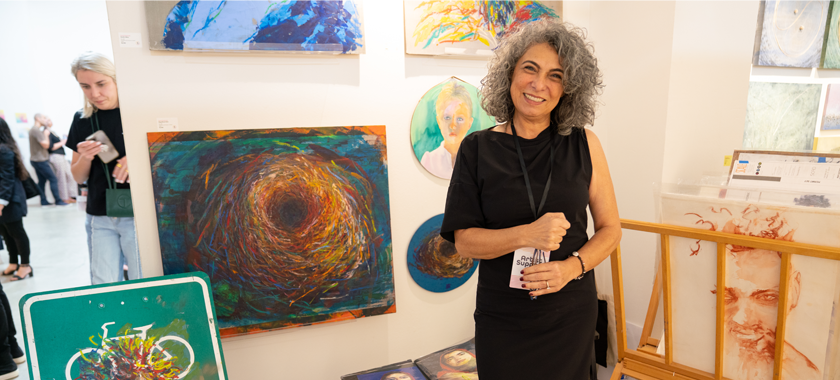
5. You Don’t Need to Spend Money on Marketing Materials.
While printed materials might be nice, they aren’t necessary. Of the printed materials you might have, Mitow prefers business cards because he is less likely to bend them, fold them, and then throw them away (which is often the case with postcards or posters). “If you’re going to make something larger that you’re giving out, maybe invest a little more in it and make it something that’s a keepsake that someone might want to have around,” he added.
Mitow is a big proponent of having a QR code or codes at your booth, ready for the scanning. “It could link to your website, to your email sign-up form, it could link to your Instagram. Wherever you pour your resources into, that’s where it should link to,” he advises.
As you’re pointing people towards information, you’ll also want to get peoples’ contact information. Mitow suggests making a sign-up sheet on a design app, then printing it out. It should include fields for their name, email address, and their favorite piece of yours. “That’s an extra step they have to take to engage with your work. The ones who are actually interested will put their favorite piece there, which makes them engage a little more with your booth,” says Mitow. It also gives you a touch point that you can use for follow-up.
Take your sign-up sheet one step further by including your own code or key. “If you have a really good conversation with someone, and they want to buy something, put a small asterisk next to their entry or whatever you want to do that doesn’t seem too heavy,” says Mitow. “You don’t want to put ‘potential buyer,’ but something that you can reference and be like, OK, I’ve got 30 emails after this fair. I’m going to prioritize these five, because I remember I had a great conversation with this person,” he added.
Don’t assume that people will fill out the form. Mitow suggests saying “Hey, you know it was really nice chatting with you. Could I grab your email address? I can send you more information about my work.” The attendees who fill out the form are your potential buyers.
6. Your Work Doesn’t End When the Fair Does.
Sales don’t always happen at the fair. This is why it is so important to have conversations and encourage email sign-ups at your booth so that you can personally follow up afterwards. “Give yourself two hours the evening the fair ends or the morning after. You don’t want it to be a week later, just within a few days of the show. If you’re local, you have an advantage. If you’re not local you have an advantage. Spend some time to make it personal. You’re going to see the rewards of that.”
If you are local, you could say something like: “Hi, Marianne, it was so nice meeting you at Superfine. I’m in the Miami area and I still have that piece that you liked at the fair. Would you like to buy it?”
If you are not local, you could say something like: “Hi Joanne, it was so nice meeting you at Superfine. I know you liked ‘Harmony in Green’ and I wanted to let you know that the piece is still available after the fair. I’m still in the Miami area. Would you like to acquire it? I can bring it by tomorrow.”
The most important aspect of both emails is that both directly ask the person if they want to buy the work. “If you are interested, please let me know. Is the worst phrase that has ever crept into our emails,” says Mitow. “Once you get into the habit of saying ‘Would you like to buy this?’ you’ll see your results increase dramatically. Don’t be afraid to do it. They paid for a ticket to come to an event where people were selling art.”
Mitow also says that exhibitors sometimes offer to take their work to someone’s home or apartment or that local artists offer studio visits, which has also worked to close sales and open doors with collectors.
A Superfine artist named Natalie Barfield found success following the fair. According to Barfield, “The NYC Superfine fair completely affected my trajectory. While I did make sales at the fair, it was what happened post-fair that mattered. I have had around 20 commissions as a result of the fair…TWENTY!”
In terms of following up to your outreach, Mitow suggests sending a simple follow-up email two days later. “If you don’t get a response, let it go,” he says. He also suggests directly putting them into your mailing list. If you tag them by city, you can reach out the next time you’ll be in town.
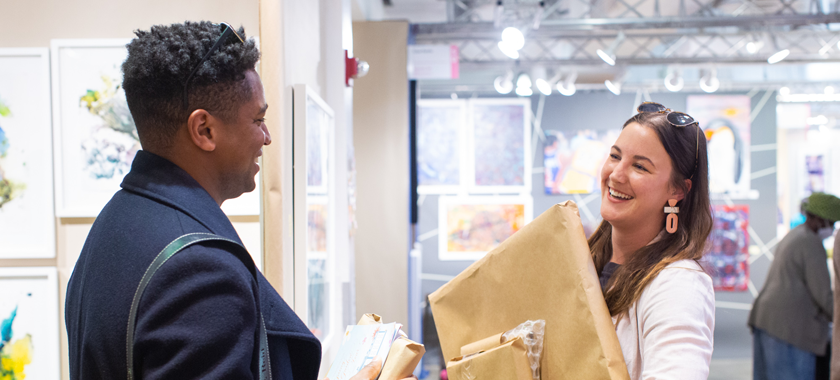
7. Your Energy Translates, so Keep it Positive.
Have fun. If you are stressed, that energy translates and people will be less likely to want to engage with you. “If you don’t look approachable, if you don’t look like someone they want to talk to, they’re not obligated to visit your booth or talk to you,” says Mitow.
“People are there for their enjoyment. Keeping a strong, positive attitude will bring people to you,” he added.
-Amy Aronoff, Senior Communications Officer
This post is part of a blog series highlighting #NYFAPartner sponsor organizations. Sign up for NYFA’s bi-weekly newsletter, NYFA News, to receive announcements about future NYFA events and programs.